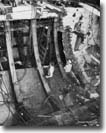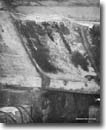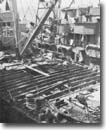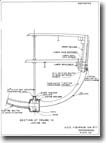|
RESTRICTED
| Ship: |
VIBURNUM (AN 57) |
| Cause of Damage: |
1 Mine |
| Date: |
November 1944 |
| Class: |
AN 38 |
| Standard Displacement: |
1275 tons |
| Length Overall: |
194' 6" |
| Beam: |
37' 0" |
| Draft Before Damage: |
11' 6" forward; 13' 6" aft |
| Launched: |
26 April 1944 |
1. VIBURNUM, a wooden hull ship, struck a contact mine at frame 12 starboard. The explosion tore a hole in the shell between frames 6 and 17 starboard and from the keel to the second deck side longitudinal (Photo 82), tore a hole in the second deck and in the port side of the main deck (Photo 83). The keelson (Photo 84) and planking about 3 feet to port were shattered between frames 7 and 18. The bolts pulled loose in connections between the shell and all bulkheads forward of frame 30. All spaces forward of bulkhead 30 flooded to the waterline as the ship took on a draft of 21 feet forward; 10 feet aft.
2. The crew undertook salvage measures that succeeded in reducing the drafts to 17' 6" forward and 12' aft. In order to accomplish this, the horns were cut off and moved to the fantail, the anchor chains were moved aft, debris was removed from the damaged spaces forward, and A-1W and the space between bulkheads 27 and 30 were made tight so that the spaces could be pumped dry. This made it possible to drydock VIBURNUM in ARDL 32 (Plate 38).
3. After VIBURNUM was drydocked, debris and damaged planking was cleared away and repairs were undertaken. Since neither materials nor trained personnel required to effect wood repairs were available, it was necessary to use steel. The keel was encased in 3/4" steel plate, which was bolted to it and extended well beyond the ends of the damage in order to provide structural continuity. The box structure surrounded the keel completely on the starboard side (Photo 85), but terminated on top of the port bilge ceiling (Photo 86). Bolts through the shell plating were used in conjunction with bolts through the wood structure to attach the steel box (Photo 87).
4. Transverse framing in the damaged area was replaced by fabricated steel T sections (Plate 39). The lower end of these frames were welded to the box girder encasing the keel structure. Their upper ends were welded to 12" H sections that were inserted and bolted through the lower
|













